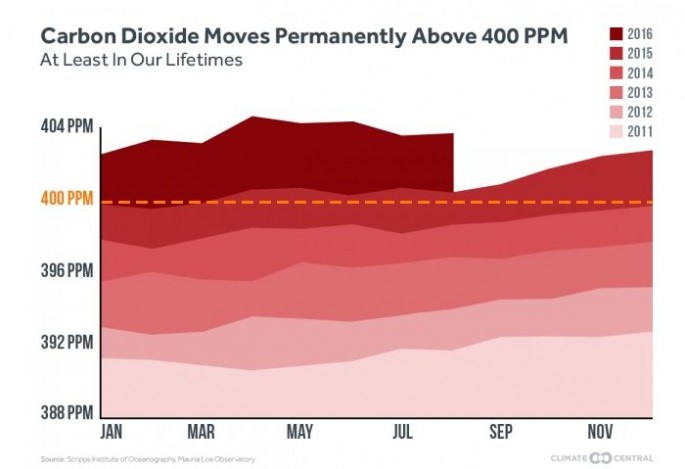The world's climate will change for the worse in the future -- perhaps for hundreds of years -- with news confirming carbon dioxide emissions for all months in 2016 will exceed 400 parts per million (ppm) for the first time.
This dubious first was made certain when atmospheric ppm, which usually falls in September, remained above the critical 400 ppm threshold. October to December normally see high concentrations of carbon dioxide.
This bleak forecast all but ensures 2016 will be the year that carbon dioxide officially passed the symbolic 400 ppm mark. This record will never fall below 400 ppm in our lifetimes, according to scientists.
Records dating back over half a century confirms that for the first time, daily and weekly values of CO2 in our atmosphere have remained above 400 parts per million, said Scripps scientist Ralph Keeling, keeper of his father's "Keeling Curve," the longest continuous record of atmospheric CO2 on Earth.
Ralph Keeling and his late father Charles David Keeling have kept CO2 measurements at the Mauna Loa Observatory in Hawaii since 1958.
"We won't be seeing a monthly value below 400 ppm this year -- or ever again for the indefinite future," said Keeling in a recent blog post.
"By November, we will be marching up the rising half of the cycle, pushing toward new highs and perhaps even breaking the 410 ppm barrier," said Keeling.
Scientists have long pointed out the increase in gases such as carbon dioxide, methane and nitrous oxide is fueling climate change. It's also making the Earth "more dangerous and inhospitable for future generations," said the World Meteorological Organization.
Increasing amounts of carbon dioxide and other gases are enhancing the planet's natural greenhouse effect.
Scientists noted that based on evidence, the last time carbon dioxide reached 400 ppm was millions of years ago. A 2009 report in the journal Nature Geoscience found evidence of CO2 levels of 365 ppm to 415 ppm some 4.5 million years ago.
Scientists also said CO2 levels were around 280 ppm before the Industrial Revolution in the late 1800s when large amounts of greenhouse gases began to be released by the burning of fossil fuels.
And why is 400 ppm a dangerous ceiling to have broken?
The website 400.350.org dedicated to monitoring the harmful effects of increasing CO2 concentrations said the safe level of carbon dioxide in the atmosphere is 350 parts per million.
"The only way to get there is to immediately transition the global economy away from fossil fuels and into into renewable energy, energy efficiency, and sustainable farming practices."
The last time CO2 levels were this high at 400 ppm, "humans did not exist. Our dependence on fossil fuels is fundamentally changing the nature of the planet -- and it's time to act."
It noted that in March, global levels of CO2 passed 400 ppm. It said this was "the first time since record keeping began that CO2 levels were above 400 ppm globally for a month.
Already we're seeing the deadly effects of climate change in the form of rising seas, monster storms, wildfires, and extreme weather of all kinds. Passing 400 ppm is an ominous sign of what might come next -- and it sends a clear signal that the world must act ahead of the UN climate talks in Paris this December"



























